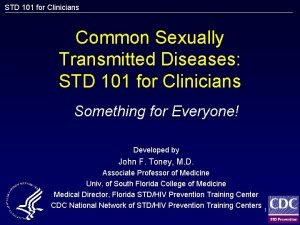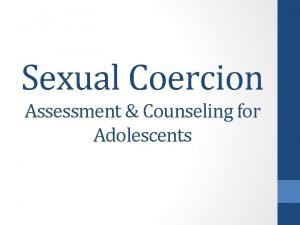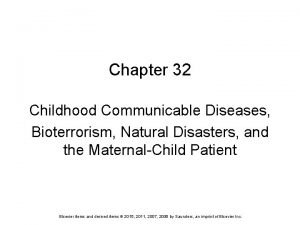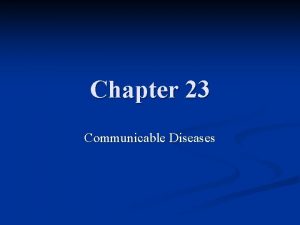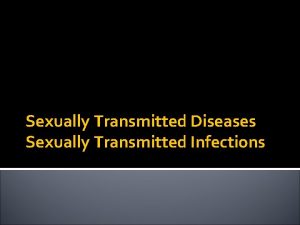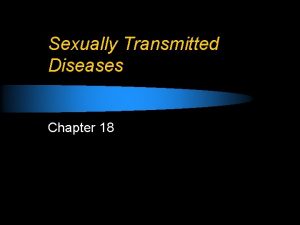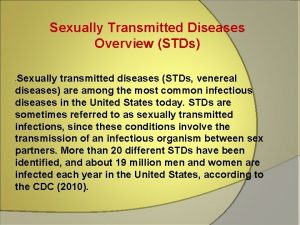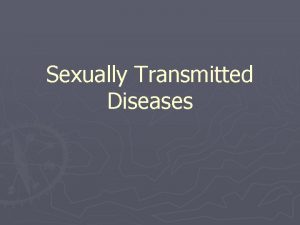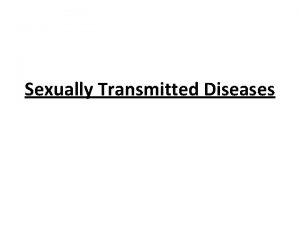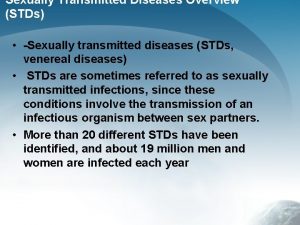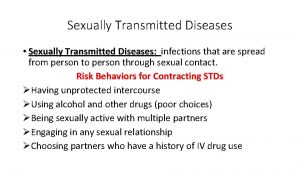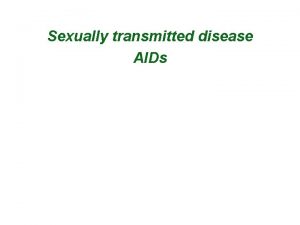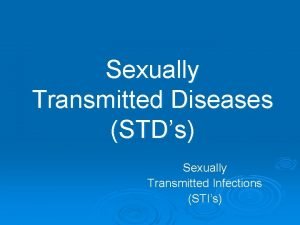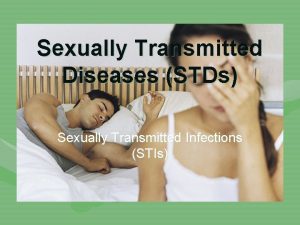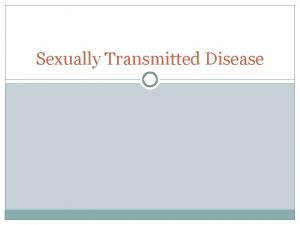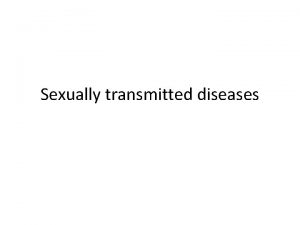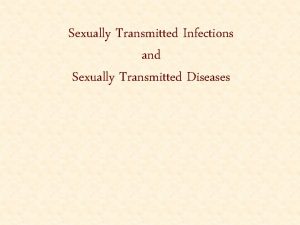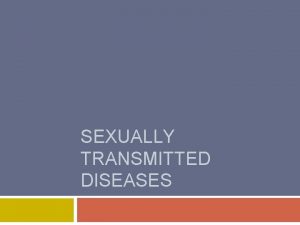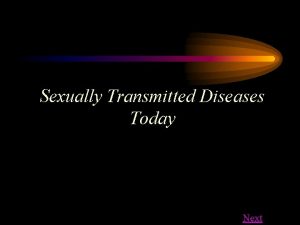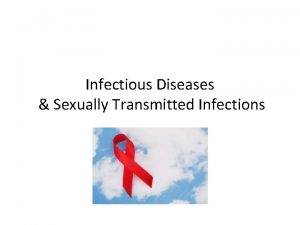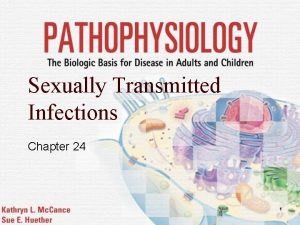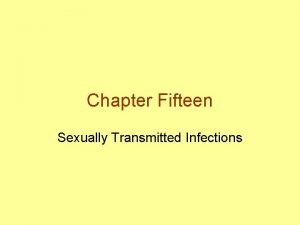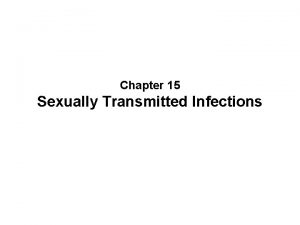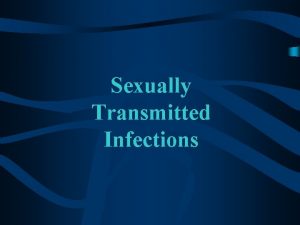Chapter 27 Sexually Transmitted Diseases 1 Only one





























- Slides: 29

Chapter 27 Sexually Transmitted Diseases 1 Only one sure means of preventing STD’s - abstinence

STD a communicable disease spread from person to person through sexual contact.

STI • Sexually Transmitted Infection

Gonorrhea • Gonorrhea - caused by bacteria that live in warm, moist areas of the body – transmitted during sexual contact • Symptoms - not always obvious – female - slight discharge, burning during urination, abnormal menstruation, & abdominal pain

– male - whitish discharge, burning during urination, and the lymph nodes in the groin may also become enlarged – symptoms appear between three days and three weeks after sexual contact • may go away on their own, but the disease is still there • Diagnosis and Treatment – diagnosis - a laboratory culture at the site of the infection – treatment - penicillin or tetracycline

• Problems from Untreated Gonorrhea – can spread in the body • high temperature • sores on the skin • pain in the joints – can lead to infertility in males & females – females - a painful infection of the fallopian tubes, ovaries, and or the uterus • pelvic inflammatory disease (PID) – in pregnant females that give birth the bacteria can enter the babies eyes and cause blindness



Syphilis • caused by a small bacterium called a: spirochete • attacks many parts of the body - most dangerous of the STD’s • symptoms – develop in stages • primary - a chancre (reddish sore at the place where the pathogen enters the body – appears within 20 to 90 days – lasts 1 to 5 weeks


• secondary – circulated in the blood – one to six months after contact – nonitching rash on the chest, back of arms, and legs – sores may develop which gives off a clear liquid filled with spirochetes – fever & sore throat – symptoms will disappear


• Latent Stage – begins two or more years after contact – all signs disappear – during this stage it attacks the heart and blood vessels and the central nervous system • Neurosyphilis Stage – appears within 10 to 30 years – the heart, skin, brain, and spinal cord are affected – during this stage it can be treated but not cured

• Diagnosis and Treatment – diagnosis - blood test (VDRL) – treatment - penicillin – early treatment is essential • penicillin cannot undo any harm that has already been done • Congenital Syphilis – meaning that the unborn child can develop syphilis any time after the fourth month – if it is diagnosed early enough in the mother penicillin treatment protects the fetus



• Clamydia – most prevalent STD in US – affects the vagina in females and the urethra in males – common cause of sterility – symptoms • males - pain & burning during urination & an unusual discharge • females - not always obvious but may include - unusual discharge, painful urination, pain in pelvic region, if untreated it can cause PID

VIRAL STD’S • Herpes 2 – herpes simplex 1 is a virus that causes herpes 1, cold sores on or around the mouth – herpes simplex 2 is a virus that causes genital herpes – transmitted by sexual contact – incurable


– symptoms • painful, itching sores in or around the genitals appearing 2 - 20 days after contact • fever and a burning sensation during urination • can spread to other areas of the body – diagnosis & treatment • examination & lab tests • can treat the symptoms • currently no cure exists • no sure way of knowing when the disease is in its contagious state

HPV • Human papillomaviruses (HPV) -common viruses that can cause warts. • There are more than 100 types of HPV. Most are harmless, but about 30 types put you at risk for cancer. • These types affect the genitals and you get them through sexual contact with an infected partner. • They are classified as either low-risk or high-risk. – Low-risk HPV can cause genital warts. – High-risk HPV can lead to cancers of the cervix, vulva, vagina, and anus in women. In men, it can lead to cancers of the anus and penis. • Although some people develop genital warts from HPV infection, others have no symptoms. Your health care provider can treat or remove the warts. In women, Pap smears can detect changes in the cervix that might lead to cancer

Warts

Cancer

HIV/AIDS • HIV- Human immunodeficiency virus • HIV is a virus that kills or damages cells of the body's immune system • Spreads through – – Unprotected sex with an infected person. May also spread by sharing drug needles Contact with the blood of an infected person. Women can give it to their babies during pregnancy or childbirth. • The first signs of HIV infection may be swollen glands and flu-like symptoms. These may come and go a month or two after infection. Severe symptoms may not appear until months or years later. • A blood test can tell if you have HIV infection. • AIDS-Acquired immunodeficiency syndrome – It is the most advanced stages of infection with the human immunodeficiency virus (HIV). . • There is no cure, but there are many medicines to fight both HIV infection and the infections and cancers that come with it.

Parasites • Very small animals that live off the host organism. – Pubic lice are the most common – Called crabs – Spread through sexual activity but can be passed from clothing or objects


Other parasites • Trichomonasis- creates “frothy” white discharge – Live in the vagina or penis – It is a protazoa


Prevention of STD’s – Very few Vaccines – no immunity built up – ONLY SURE WAY NOT TO CONTRACT AN STD IS NOT TO BE SEXUALLY ACTIVE. – IF YOU CHOSE TO BE SEXUALLY ACTIVE IT IS YOUR RESPONSIBILITY TO TAKE PRECAUTIOINS.
 Chapter 24 lesson 1 sexually transmitted diseases
Chapter 24 lesson 1 sexually transmitted diseases Chapter 24 sexually transmitted diseases and hiv/aids
Chapter 24 sexually transmitted diseases and hiv/aids Std
Std Sexually transmitted diseases
Sexually transmitted diseases Chapter 25 sexually transmitted infections and hiv/aids
Chapter 25 sexually transmitted infections and hiv/aids Sexually transmitted disease
Sexually transmitted disease How do whales reproduce sexually
How do whales reproduce sexually Segmentation of platyhelminthes
Segmentation of platyhelminthes Spider phylum
Spider phylum Unokais
Unokais Rules of consent
Rules of consent Reproduction
Reproduction Sexual abuse quiz
Sexual abuse quiz Class concentricycloidea characteristics
Class concentricycloidea characteristics Structure of protists
Structure of protists Vasocongestion definition
Vasocongestion definition Do worms reproduce sexually or asexually
Do worms reproduce sexually or asexually Have i been sexually harassed quiz
Have i been sexually harassed quiz Sexual propagation
Sexual propagation Cnidaria class
Cnidaria class Do jellyfish reproduce sexually
Do jellyfish reproduce sexually Sexually frustrated meaning
Sexually frustrated meaning Spongia officinalis
Spongia officinalis How birds reproduce sexually
How birds reproduce sexually Dimorphism meaning
Dimorphism meaning Illinois sex offender management board
Illinois sex offender management board Retention hyperkeratosis dermnet
Retention hyperkeratosis dermnet Chapter 6 musculoskeletal system diseases and disorders
Chapter 6 musculoskeletal system diseases and disorders Chapter 32 childhood communicable diseases bioterrorism
Chapter 32 childhood communicable diseases bioterrorism Sarophytes
Sarophytes





